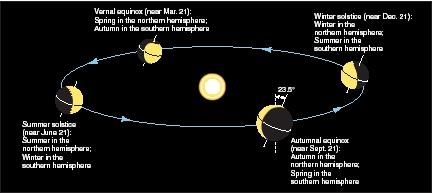Seasons
Seasons on Earth are characterized by differences in temperature and the length of daylight. The four distinct seasons—spring, summer, autumn (or fall), and winter—are found only in the temperate zones. These zones extend from 23.5 degrees North (and South) latitude to 66.5 degrees North (and South) latitude. The equatorial regions or torrid zones have no noticeable seasonal changes, only a wet season and a dry season. Polar regions experience only a light season and a dark season.
Spring comes from an Old English word meaning "to rise." Summer originated as a Sanskrit word meaning "half year" or "season." Autumn comes originally from a Etruscan word for "maturing." Winter comes from an Old English word meaning "wet" or "water."
In the Northern Hemisphere, astronomers assign an arbitrary starting date for each season. Spring begins around March 21, summer around June 22, autumn around September 23, and winter around December 22. In the Southern Hemisphere, the seasons are reversed with spring beginning in September, summer in December, fall in March, and winter in

June. Seasons in the Southern Hemisphere are generally milder because of the larger amounts of ocean surface in that hemisphere. Since oceans heat up and cool down much slower than landmasses, they exert a moderating force on temperatures.
Reason for the seasons
Earth makes one complete revolution about the Sun each year. Changes in the seasons are caused not by the varying distance between Earth and the Sun, but by the tilt of Earth on its axis during that revolution. (Earth's axis of rotation is tilted 23.5 degrees to the plane of its orbit.) As Earth orbits the Sun, there are times of the year when the North Pole is alternately tilted toward the Sun (during Northern Hemispheric summer) or tilted away from the Sun (during Northern Hemispheric winter). At other times the axis is generally parallel to the incoming Sun's rays.
Words to Know
Autumnal equinox: Date in the fall of the year when Earth experiences 12 hours of daylight and 12 hours of darkness, usually around September 23.
Summer solstice: Date on which the Sun is highest in the sky at noon in the Northern Hemisphere, usually around June 22.
Temperate zones: Two regions on Earth bounded by 23.5 degrees latitude and the 66.5 degrees latitude.
Torrid zone: Zone on Earth bounded by 23.5 degrees north and south latitude.
Vernal equinox: Date in the spring of the year when Earth experiences 12 hours of daylight and 12 hours of darkness, usually around March 21.
Winter solstice: Date on which the Sun's noontime height is at its lowest in the Northern Hemisphere, usually on December 22.
During summer, two effects contribute to produce warmer weather. First, the Sun's rays fall more directly on Earth's surface, producing a stronger heating effect. Second, daylight hours outnumber nighttime hours. The Sun's rays warm Earth during daylight hours and Earth cools at night by reradiating heat back into space. Since there are longer periods of daylight and shorter periods of darkness during the summer, Earth receives more solar heat then it releases back into space. Thus, areas experiencing summer stay warmer.
The equinox
When the axis of Earth is perfectly parallel to the incoming rays of the Sun in spring—around March 21—the Sun rises in a direction that is due east everywhere on Earth and stands directly over the equator at noon. As a result, daylight hours equal nighttime hours everywhere on Earth. This effect gives rise to the name given to this date, the vernal equinox. Vernal comes from the Latin word for "spring," while equinox is formed from the Latin word for "equal night." The corresponding date in the fall when 12 hours of daylight and 12 hours of darkness occur everywhere on Earth—around September 23—is known as the autumnal equinox.
The solstice
After the vernal equinox, the Sun continues to move in a northward direction and rise a little farther north of east each day until around June 22. On this day, the Sun has reached its extreme northward position and seems to stand still in its noon height above the horizon. For this reason, the date is known as the summer solstice, from the Latin words meaning "sun stands still." The summer solstice, the longest day and shortest night of the year in the Northern Hemisphere, marks the beginning of summer in the Northern Hemisphere. Afterward, the Sun begins to move southward. It crosses the celestial equator (the autumnal equinox) and continues to move southward, rising a little farther south of east each day until it reaches its most extreme southward position around December 22—the winter solstice (the shortest day and longest night in the Northern Hemisphere). Afterward, the Sun begins its northward movement back to the vernal equinox.
Celebrating the seasons
Early societies celebrated the changes in the seasons on some of these cardinal dates. The vernal equinox was a day of celebration for the early Celtic tribes in ancient England, France, and Ireland. Other northern European tribes also marked the return of warmer weather on this date. Even the winter solstice was a time to celebrate, as it marked the lengthening days that would lead to spring. The ancient Romans celebrated the Feast of Saturnalia on the winter solstice. And even though there are no historical records to support the choice of a late December date for the birth of Jesus of Nazareth, Christians in the fourth century A.D. chose to celebrate Jesus' birth on the winter solstice. In the Julian calendar system in use at that time, this date fell on December 25.
[ See also Calendar ; Global climate ]
Comment about this article, ask questions, or add new information about this topic: